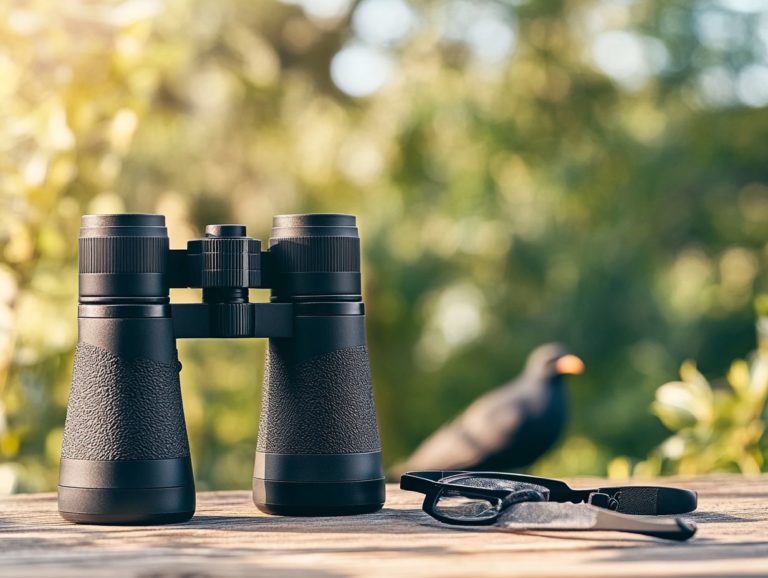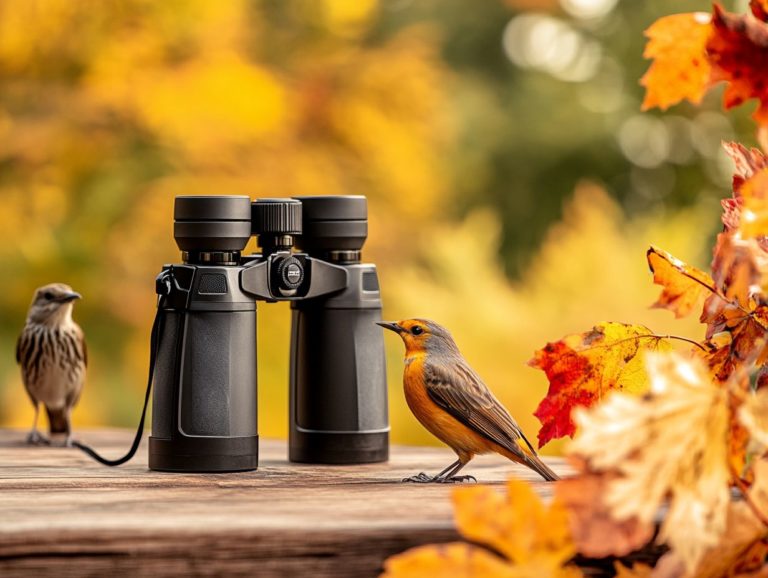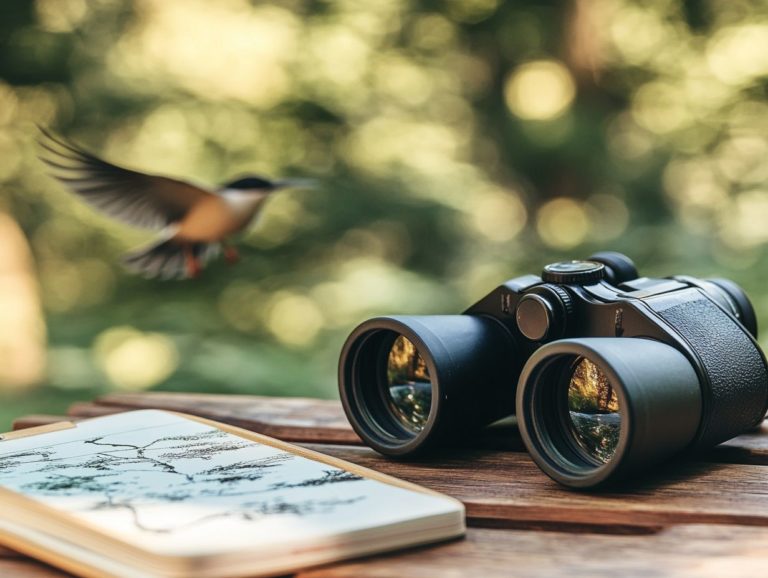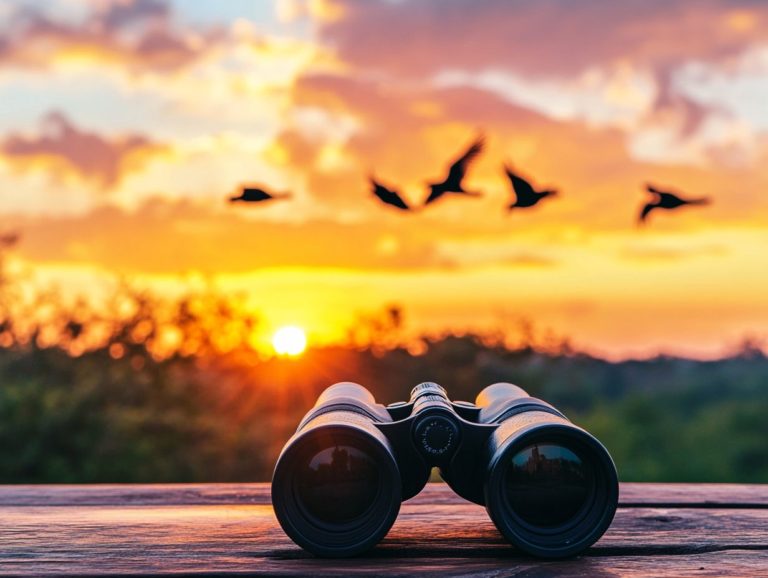How to Properly Hold Binoculars for Best Viewing
Binoculars can transform your view of the world around you. Whether you’re birdwatching, stargazing, or enjoying a beautiful landscape, they enhance every experience.
Familiarizing yourself with the components and functions of binoculars is key to maximizing your experience. Mastering how to hold them and adjusting them to your vision enhances viewing pleasure.
This article provides valuable tips for achieving steady views and maintaining your binoculars, ensuring they stay in prime condition for all your explorations. Get ready to elevate your skywatching adventures with these tips!
Contents
- Key Takeaways:
- Understanding the Basics of Binoculars
- Properly Holding Binoculars for Best Viewing
- Tips for Steady Viewing
- Maintaining and Cleaning Your Binoculars
- Proper Storage and Care
- Cleaning and Maintenance Tips
- Frequently Asked Questions
- How should I hold binoculars for best viewing during skywatching sessions?
- What is the proper way to hold binoculars to avoid shaky images?
- Is there a specific way to hold binoculars when wearing glasses?
- How can I hold binoculars for best viewing if I have small hands?
- Do I need to hold binoculars differently when viewing moving objects?
- What is the recommended way to hold binoculars for extended periods?
Key Takeaways:
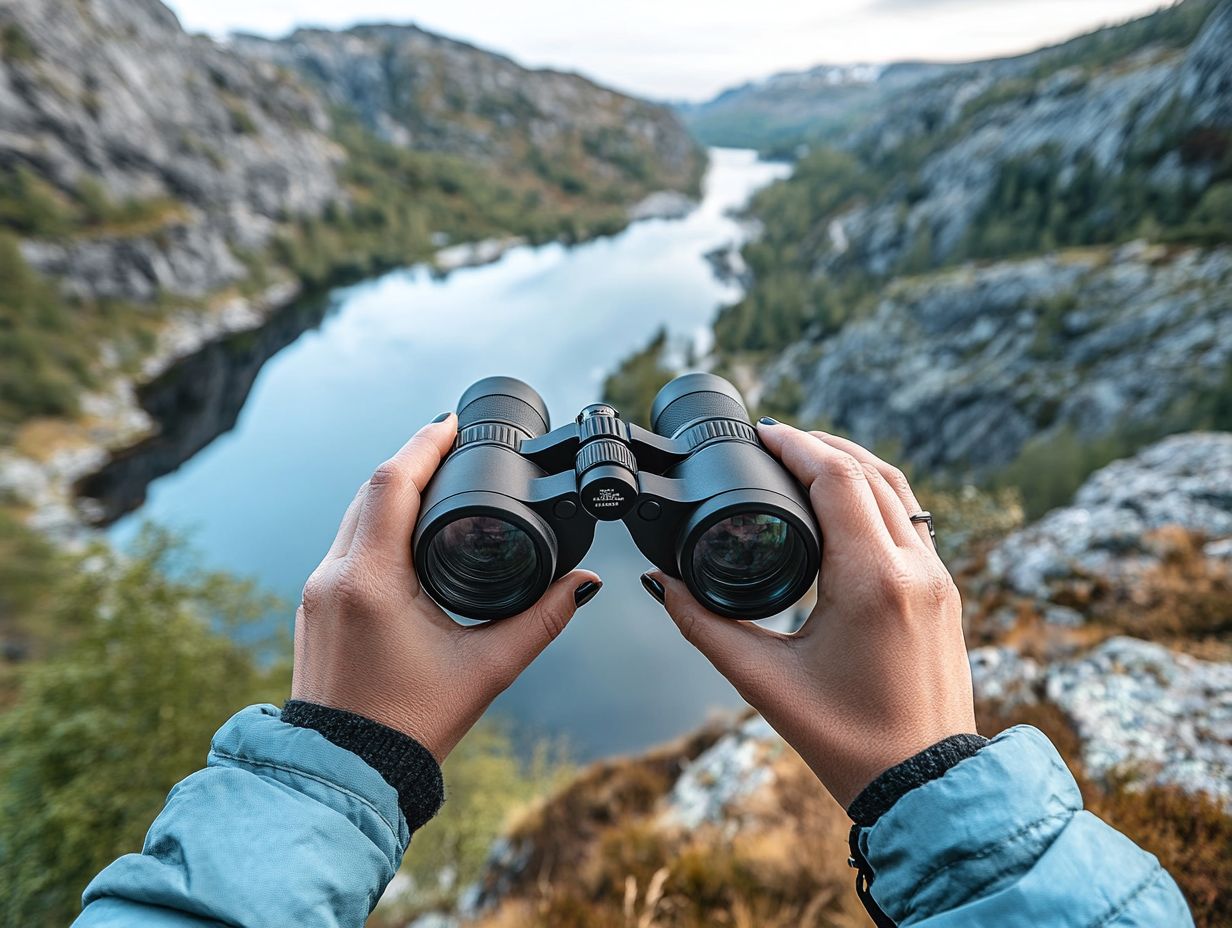
- Place your hands on the binoculars correctly – with your fingers around the barrels and your thumbs on the center hinge – for a steady and comfortable view.
- Adjust the diopter to match any differences between your eyes. This ensures a clear image.
- Utilize a tripod or practice proper breathing techniques to minimize hand tremors, allowing for a more stable and enjoyable viewing experience.
Understanding the Basics of Binoculars
Grasping the fundamentals of binoculars is crucial for anyone captivated by astronomy and eager to embark on skywatching adventures. These remarkable optical instruments enable you to magnify distant objects, allowing you to appreciate the beauty of celestial bodies such as stars and planets in all their glory.
Binocular magnification can vary greatly. Choosing the right type of binoculars for your needs whether that means opting for binoculars that reduce shaking in unstable environments or selecting higher power binoculars for those deep-space explorations is vital.
Parts and Functions of Binoculars
Binoculars consist of several crucial components that harmonize to elevate your skywatching experience, including lenses, prisms, and the focus wheel.
The ocular and objective lenses are particularly significant. The ocular lens grants you the ability to see distant objects with remarkable clarity, while the objective lens captures light, ensuring that your view is bright and detailed. Together, these lenses provide magnification without sacrificing quality.
Intricate prisms enhance the design by correcting the image orientation, allowing you to enjoy celestial wonders the right way up. The focus wheel is essential for fine-tuning clarity, enabling you to zoom in on specific features, whether it’s the craters of the moon or far-off galaxies.
These components work together seamlessly, ensuring that your stargazing experience is as immersive and enjoyable as possible.
Properly Holding Binoculars for Best Viewing
Holding binoculars correctly is essential for attaining a clear and stable view, particularly during those lengthy skywatching sessions. The ideal grip involves balancing the binoculars comfortably in your hands while supporting your elbow to minimize any shaking.
Employing a binocular neck strap can also alleviate fatigue, ensuring that your binoculars remain steady throughout prolonged use. A light grip will also enhance your control, enabling you to make adjustments effortlessly without introducing unnecessary motion.
Correct Hand Placement
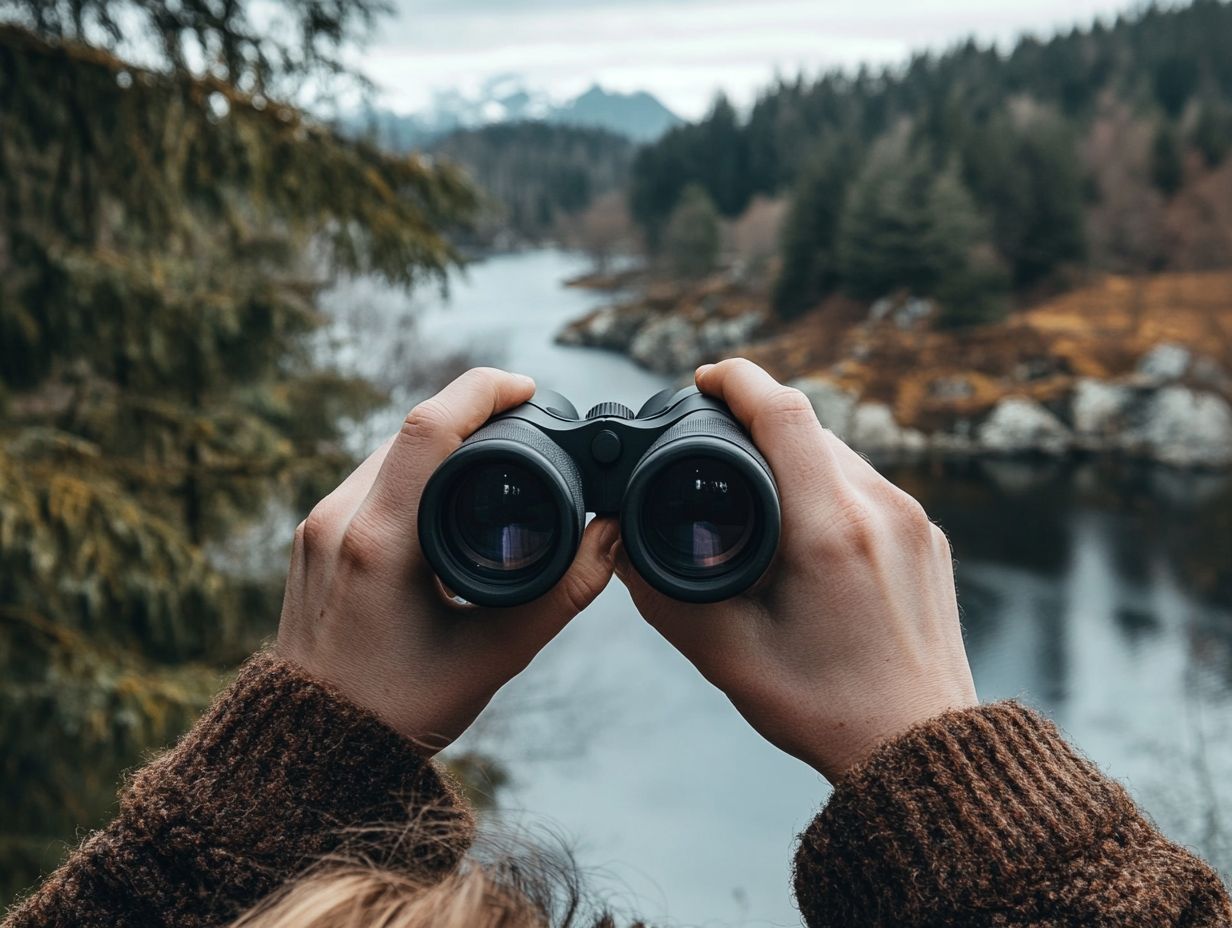
Correct hand placement when holding binoculars is crucial for a steady view and minimizing fatigue during your skywatching sessions. This allows for better binocular support and control.
Position both hands firmly on the binoculars. Your thumbs should support the bottom, while your fingers wrap comfortably around the sides. This creates a solid grip that keeps unnecessary movement at bay. You might also consider the walking stick trick, where you rest the binoculars on a walking stick or any stable surface. This technique helps stabilize your view even further and enhances your overall tripod stability.
Tucking your elbows into your sides provides excellent support. This significantly enhances comfort and steadiness while you gaze at distant celestial bodies. Enjoy a more immersive and pleasurable observational experience!
Adjusting for Individual Eye Differences
Adjusting binoculars for your individual eye differences is essential for achieving clarity and comfort as you explore the wonders of the night sky.
Use the focus wheel for each eye to tailor your viewing experience to your unique vision. This simple adjustment enables sharper imagery, especially when gazing at distant stars or planets with higher power binoculars.
Image-stabilized binoculars offer clearer views for those with varying eye strengths. This technology minimizes the impact of hand tremors and environmental movement, allowing you to fully immerse yourself in the exquisite details of the cosmos.
Tips for Steady Viewing
Achieving steady viewing is essential for a truly enjoyable skywatching experience. Here are practical tips to minimize shaking while using binoculars.
Using a Tripod or Other Stabilizing Device
Using a tripod or other stabilizing devices significantly elevates your viewing experience. They provide a steady platform for your binoculars.
This becomes particularly advantageous during extended observations, whether you’re scanning the night sky or indulging in a lengthy birdwatching session. The natural tremors that come with hand-held viewing can compromise clarity, making a tripod or stabilizing mount a wise investment.
These setups not only stabilize your binoculars for more comfortable and prolonged viewing but also free your hands for note-taking or managing other equipment. Inexpensive adapters are readily available, allowing astronomy enthusiasts and nature lovers to enhance their optical experience.
With these tools, you can revel in the mesmerizing details of our universe without straining your budget!
Proper Breathing Techniques
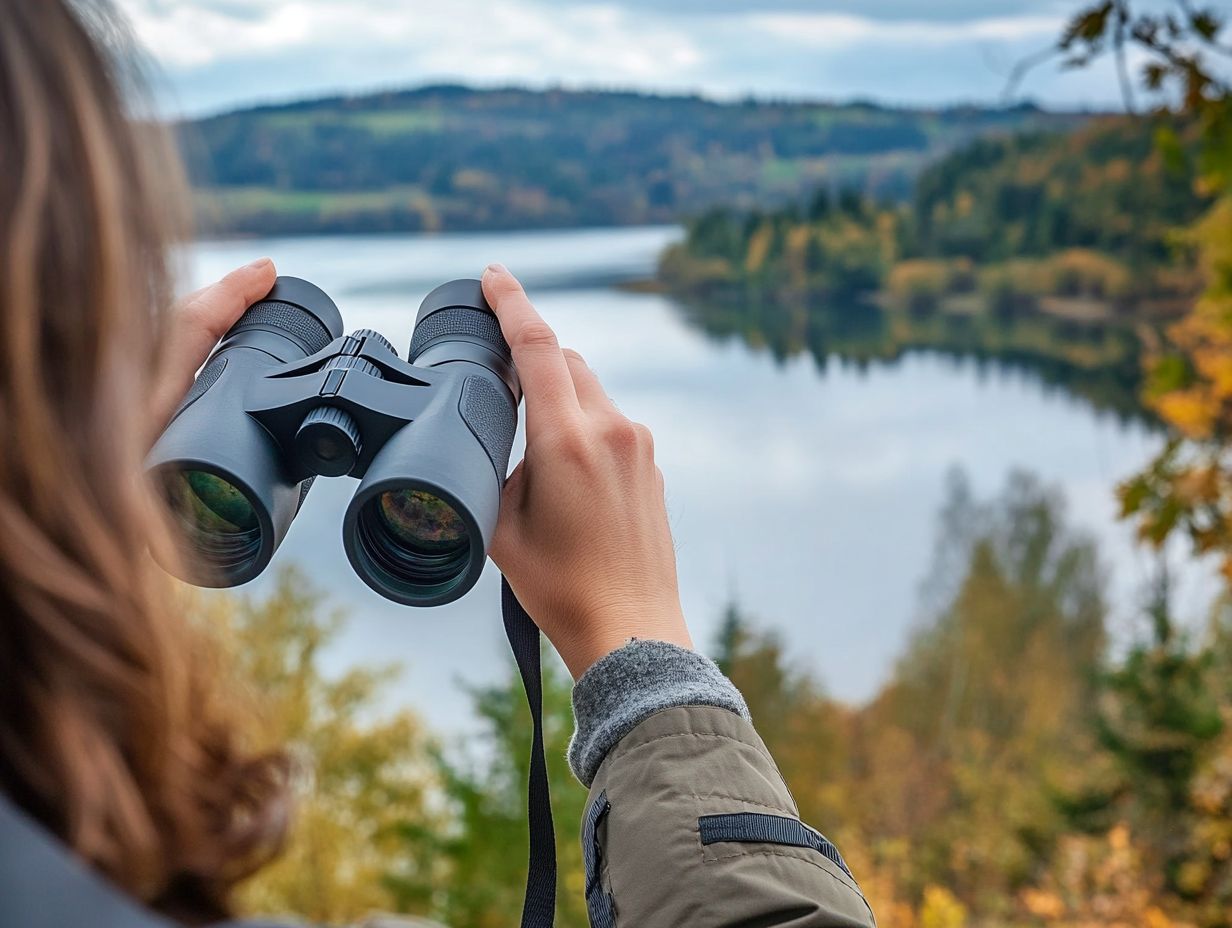
Proper breathing techniques are often overlooked, yet they play a vital role in reducing shaking and enhancing your focus while using binoculars.
Adopt a methodical approach to breathing. Inhale deeply through your nose for a count of four, then exhale slowly through your mouth for a count of six. This helps establish a calming rhythm for your body and mind.
Slow, controlled breathing minimizes unnecessary movements. When combined with other stabilization methods, like using a tripod or leaning against a solid surface, your viewing experience will significantly improve!
Maintaining and Cleaning Your Binoculars
Maintaining and cleaning your binoculars is crucial for preserving their optical performance and longevity. This ensures they remain a dependable companion for all your skywatching adventures, enhancing your binocular techniques for better clarity.
Proper Storage and Care
Proper storage and care of your binoculars can significantly extend their lifespan. This ensures they re always primed and ready for those perfect moments.
Invest in high-quality cases and soft materials that protect your binoculars from bumps. Storing your binoculars in a cool, dry place is vital; this helps protect against moisture and temperature changes that can degrade their performance.
Regular cleaning keeps your binoculars in great shape. Keeping the lenses crystal clear for breathtaking views not only enhances visibility but also prevents scratches, ensuring you can see through them well during your viewing sessions.
By prioritizing protection and cleanliness, you can maintain your equipment in optimal condition, ready to capture life s fleeting moments with stunning clarity.
Cleaning and Maintenance Tips
Regular cleaning is essential for keeping your binoculars in pristine condition. Ensure that dirt or smudges do not affect lens clarity.
Without proper care, the performance of the optics can decline, making it hard to enjoy those breathtaking views. Start with a microfiber cloth designed for optics, as it lifts dust without scratching the lens. A lens brush or an air blower can help remove larger particles that could scratch the lenses during cleaning.
For stubborn stains, just a few drops of lens cleaning solution on the cloth can work wonders. Avoid household cleaners or paper towels; these can damage the delicate coatings on the lenses. Implement a cleaning routine every few months or after heavy use to maintain the functionality of your binoculars.
Frequently Asked Questions

How should I hold binoculars for best viewing during skywatching sessions?
To hold binoculars for the best viewing, first make sure the eyepieces are at the correct distance for your eyes. Place your thumbs underneath the eyepieces and your fingers around the barrels. For more detailed instructions on how to use binoculars for bird watching safely, use your index fingers to adjust the focus wheel as needed.
What is the proper way to hold binoculars to avoid shaky images?
The best way to avoid shaky images is to use both hands. Grip the barrels with one hand and place the other hand on top, supporting the weight with your fingers for stability.
Is there a specific way to hold binoculars when wearing glasses?
When wearing glasses, hold binoculars slightly further from your eyes. Make sure the eyecups are fully extended and rest the eyepieces against your glasses to prevent scratching.
How can I hold binoculars for best viewing if I have small hands?
If you have small hands, consider using a neck strap or tripod to help support the weight. Look for binoculars with a smaller grip size or adjustable eyepieces for a comfortable fit.
Do I need to hold binoculars differently when viewing moving objects?
Yes, when viewing moving objects, hold binoculars with a wider grip and use your arms to track the movement. This will help maintain focus and avoid blurry images.
What is the recommended way to hold binoculars for extended periods?
If you plan to use binoculars for extended periods, take breaks to rest your arms. A tripod or monopod can support the weight, especially if using a larger or heavier pair.


